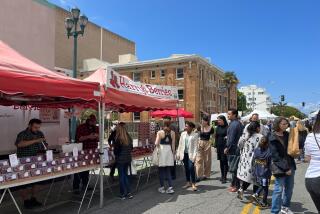The Word From Mr. Strawberry : ‘Douglas’ Is the Best Variety, Says Victor Voth. And December, the Best Time to Plant
William Butler, a 16th-Century English physician, had this to say about the strawberry: “Doubtless God could have made a better berry, but doubtless God never did.” Since we in Southern California live in the world’s prime commercial strawberry belt, it would be a shame if we didn’t devote some space in our gardens to this glorious berry.
Although commercial growers plant strawberries in late October and November, not many plants are available to the home gardener during those months. But by December, strawberry plants begin to show up in local nurseries. If you plant them now, you should have your first fruit by mid-March.
And, yes, it is possible to grow luscious, large berries, just like the commercial growers produce, right in your own yard. To get an expert’s opinion on how it can be done, we visited Victor Voth, known to growers as “Mr. Strawberry.” From a research station near the El Toro Marine Corps Air Station in Orange County, Voth, a University of California pomologist, grows and tests more than 6,000 strawberry hybrids each year. From these he selects only about l50 that he deems worthy of further testing. Each superior variety he produces requires about l0 years of testing and refining.
For 40 years Voth has been developing strawberry varieties for growers and helping them improve their planting techniques. He has brought the humble berry a long way. The year 1985 saw the largest commercial strawberry harvest in history, with resultant lower prices to growers. Some growers good-naturedly blamed Voth, claiming that he has made strawberries too productive and too easy to grow.
Along with a colleague, R. S. Bringhurst of UC Davis, Voth developed the commercial varieties grown in Southern California and most of the varieties sold as plants in local nurseries. A Voth-developed berry called ‘Douglas’ makes up about 90% of the locally grown crop. The other 10% is ‘Chandler,’ another Voth development. ‘Douglas’ and ‘Chandler’ plants can be found in local nurseries, although ‘Sequoia,’ also from Voth, is even more likely to be in stock. All three varieties are suitable for home gardens. ‘Douglas’ has a sweet-tart flavor as well as a solid texture that makes it good for shipping. It’s Voth’s favorite eating berry. ‘Sequoia’ and ‘Chandler’ are sweeter, without much of the tartness associated with strawberry flavor. ‘Sequoia’ doesn’t ship well and therefore is not used commercially. It is, however, a prime candidate for the home garden. ‘Tioga’ plants, an old-time Voth development, also may be available. ‘Tioga,’ Voth says, is a satisfactory home-garden variety but doesn’t produce berries as large as the others.
To grow those large, luscious berries in your garden, choose a variety designed for Southern California. Strawberries are a highly regional crop; varieties that produce well in one section of the country may do poorly in others.
Once you’ve bought your plants, choose a sunny location for the strawberry patch; full sun is a must. Prepare the soil by spading into it large amounts of organic materials such as compost or peat moss. That will help provide proper soil drainage, an important part of strawberry culture.
Mix in a timed-release fertilizer, such as Osmocote, but water the soil thoroughly before planting. Follow label directions as to how much fertilizer to apply. Depending on the brand, timed-release fertilizers will last anywhere from three to six months.
The correct planting procedure is critical. Set the plants 12 inches apart in rows spaced 18 inches apart. With a trowel, make a crevice in the soil and bury the plant so that the middle of the crown is even with the soil line. If you plant them too shallow, the tops of the roots will be exposed, and the plants will dry out. If you plant them too deep, with the crown covered, they’ll rot. Sprinkle the transplants daily for about a week, or until they become established. After that, if it doesn’t rain, water them weekly. Keep the plants weeded. Commercial growers use a clear plastic mulch around plants to warm the soil and speed growth and production.
From a December planting, Voth says, and depending on the climate, berries will be harvested from mid-March through early June. During that time, the plants will put out runners. To improve fruit size, cut off the runners as soon as they appear. On July 1, stop cutting the runners and allow the plants to form all the runners they can until Oct. 15. Then cut the runners from the parent plants and gently dig them up without damaging the newly formed root system. Carefully remove all foliage except two healthy leaves in the center of each runner.
Put the runners in a polyethylene bag no thicker than 1 millimeters. Put the bag into a refrigerator--not into the freezer--in a spot where the temperature will range between 38 to 40 degrees Fahrenheit. Leave them there for 20 days.
These runners will become your strawberry plants for next year, having met the chilling requirement they needed to set early crops of very large fruit. While the runners are chilling in the refrigerator, dig up and discard the old plants and prepare the strawberry bed as you did the previous year.
At the end of the 20-day chilling period, remove the runners from the refrigerator and follow the planting technique described above. Under normal weather conditions, new plants set out around the first week of November will produce their first fruit after about 2 1/2 months.
Although this method can be used to produce delectable fruit for several years, Voth recommends buying new plants after the third year and starting the planting procedure over again.






